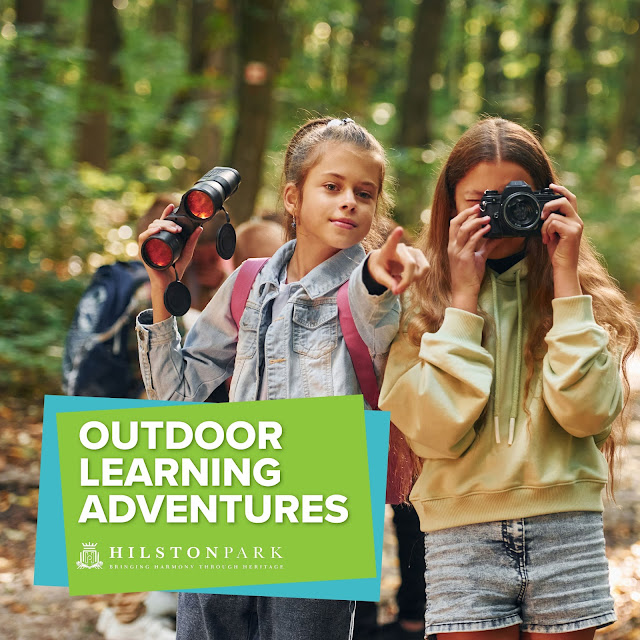Exploring the Great Outdoors - Transformative Outdoor Learning Activities for All Ages
Introduction:
In a world dominated by technology, the value of outdoor
learning activities cannot be overstated. This blog explores
the myriad benefits of taking education beyond the classroom walls and
immersing learners in nature. From fostering a deeper connection with the
environment to enhancing cognitive skills, outdoor learning has the power to
transform education. Let's delve into a variety of engaging activities that
bring learning to life under the open sky.
The Benefits of Outdoor Learning:
Before diving into specific activities, let's examine the
numerous advantages of incorporating outdoor learning into educational
practices. Research indicates that exposure to nature enhances concentration,
reduces stress levels, and promotes overall well-being. Outdoor learning
encourages hands-on experiences, fostering a sense of curiosity and
exploration. It also promotes teamwork, problem-solving, and adaptability,
essential skills for success in the modern world.
Engaging Outdoor Learning Activities:
1. Nature Scavenger Hunts:
Encourage observation skills and teamwork by organizing nature scavenger hunts. Provide students with lists of items to find or clues to follow, allowing them to explore the natural surroundings actively.
2. Botanical Sketching and Journaling:
Foster creativity and an appreciation for biodiversity by incorporating botanical sketching into outdoor activities. Students can create nature journals, documenting their observations and sketches of plants, flowers, and insects.
3. Outdoor Science Experiments:
Take science lessons outdoors with hands-on experiments. Whether it's exploring ecosystems, studying the life cycle of insects, or experimenting with simple physics concepts, the outdoor environment provides a dynamic and interactive setting.
4. Geocaching Adventures:
Combine technology and outdoor exploration with geocaching. This GPS-based treasure hunt not only promotes physical activity but also introduces participants to navigation skills and geographical concepts.
5. Outdoor Reading Circles:
Transform reading sessions into memorable experiences by taking them outdoors. Whether under a tree or in a designated outdoor reading area, literature comes alive in the midst of nature.
6. Historical Outdoor Tours:
Integrate history lessons with outdoor tours of local historical sites. Students can explore the historical significance of their surroundings, gaining a deeper understanding of the past.
7. Environmental Stewardship Projects:
Instil a sense of responsibility by engaging in environmental stewardship projects. Planting trees, creating wildlife habitats, or participating in community clean-ups teach students the importance of caring for their surroundings.
8. Math Trail Adventure:
Turn a math lesson into an outdoor adventure by creating a math trail. Place mathematical problems or challenges at different points along the trail, and students solve them as they explore nature. This not only reinforces math skills but also encourages physical activity.
9. Astronomy Nights:
Take advantage of clear nights for stargazing sessions. Students can learn about constellations, planets, and celestial phenomena. Consider partnering with local astronomy clubs or experts to enhance the experience with telescopes and expert insights.
10. Nature-inspired Art Classes:
Conduct art classes outdoors, encouraging students to draw inspiration from nature. Whether it's sketching landscapes, painting flowers, or creating natural sculptures, this allows for artistic expression while fostering a deeper connection to the environment.
11. Bird Watching and Identification:
Introduce students to the world of ornithology by organizing bird watching sessions. Provide binoculars and bird identification guides, and encourage students to document the different bird species they observe. This activity promotes patience, observation skills, and an understanding of biodiversity.
12. Outdoor Leadership Challenges:
Develop leadership and teamwork skills through outdoor challenges. Activities like ropes courses, trust falls, and problem-solving initiatives provide students with opportunities to work collaboratively, communicate effectively, and overcome obstacles.
13. Weather Stations and Meteorology:
Set up a small weather station outdoors, complete with thermometers, barometers, and rain gauges. Students can take daily weather readings, analyze patterns, and even predict the weather. This hands-on approach to meteorology enhances scientific understanding and observation skills.
14. Outdoor Language Arts Activities:
Conduct language arts activities in nature, such as
storytelling circles, poetry writing, or even outdoor plays. The natural
surroundings provide inspiration and a unique backdrop for creative expression.
Conclusion:
As educators and parents seek innovative ways to enhance the learning experience, outdoor learning activities emerge as a powerful and enjoyable solution. By immersing learners in the natural world, we not only foster a love for the environment but also nurture holistic development. From scientific exploration to artistic expression, the possibilities for outdoor learning are as vast as the great outdoors itself. Embrace the transformative potential of outdoor education and watch as it inspires a lifelong love of learning in students of all ages.



Comments
Post a Comment